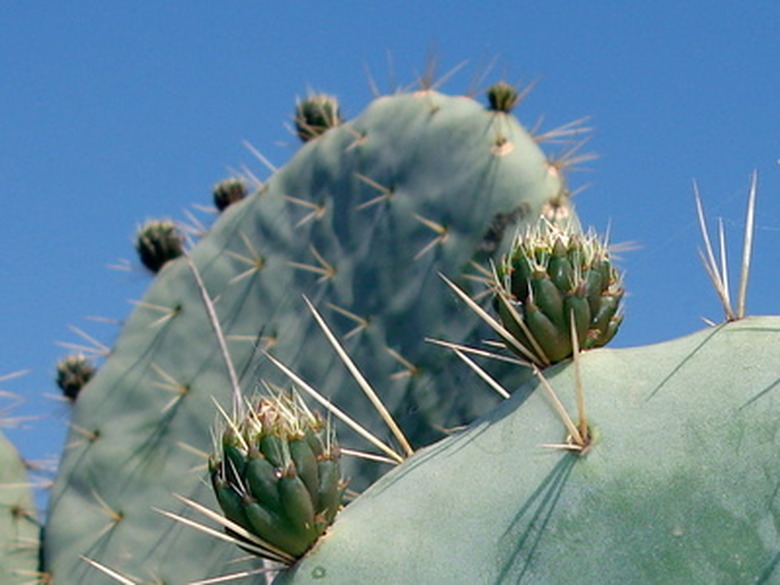How To Find Out What Kind Of Cactus You Have
Cacti come in all kinds of shapes, colors and sizes. Perhaps out of curiosity you want to know how best to take care of your cactus, or maybe you just want to know what to tell your friends when they ask you about it. Either way, figuring out your distinct cactus's characteristics will help you down the road to finding it's true identity. Like superheroes, many plants we assume are cacti actually have secret identities and aren't cacti at all. Only careful observation will be able to distinguish the real from the incognito.
Step 1
Consult a field guide. This is the easiest of methods for discovering the type of cacti you own. Simply look up the characteristics of the cactus in the field guide (types of flower, size, shape, color, etc) and see if you can find a cactus that closely resembles yours. While you may not find an exact match, at least the closest entry will point you in the right direction.
- Cacti come in all kinds of shapes, colors and sizes.
- Simply look up the characteristics of the cactus in the field guide (types of flower, size, shape, color, etc) and see if you can find a cactus that closely resembles yours.
Step 2
Compare your "cactus" against non-cacti characteristics. Common nomenclature has generalized the specific title of cactus to mean a variety of plants. You know for sure that you have a cactus if the following are true: it has an "aereoles," spines (not thorns), unique cacti flowers, the presence or absence of certain type of leaves, and if it was originally found only in the Americas, or nearby islands.
Step 3
Search for your cactus on a geographical distribution site, such as is available on cactiguide.com. This will help you pin-point the cactus according to where you found it, and is particularly helpful if you found the cactus in the wild.
Kinds Of Cactus Fruit
Red and yellow dragon fruit are two kinds of cactus fruits that come from the yellow and red pitaya vine cactus (Selenicereus megalanthus). This plant requires frost protection in climate zones below U.S. Department of Agriculture plant hardiness zones 9b. The yellow-hued dragon fruit from the yellow pitaya has a bolder, sweet taste and is usually the more expensive of the two. Thriving in USDA zone 9, the fruit of the columnar cactus (Cereus peruvianus) is medium in size, smooth and without spines. Fruits develop along the long columns of the cactus in sporadic clusters. Cactus fruits come in a variety of shapes and sizes. White-fleshed varieties are most common in Mexico and used in cooking applications. A stringy, fibrous, sour and acidic variety called xoconochtlis is a traditional cactus fruit in stews and side dishes. Cactus fruits with deeper hued flesh, such as purple, red or orange, are sweeter and less sour to taste.
- Red and yellow dragon fruit are two kinds of cactus fruits that come from the yellow and red pitaya vine cactus (Selenicereus megalanthus).
- Thriving in USDA zone 9, the fruit of the columnar cactus (Cereus peruvianus) is medium in size, smooth and without spines.
Kinds Of Cactus Fruit
Red and yellow dragon fruit are two kinds of cactus fruits that come from the yellow and red pitaya vine cactus (Selenicereus megalanthus). This plant requires frost protection in climate zones below U.S. Department of Agriculture plant hardiness zones 9b. The yellow-hued dragon fruit from the yellow pitaya has a bolder, sweet taste and is usually the more expensive of the two. Thriving in USDA zone 9, the fruit of the columnar cactus (Cereus peruvianus) is medium in size, smooth and without spines. Fruits develop along the long columns of the cactus in sporadic clusters. Cactus fruits come in a variety of shapes and sizes. White-fleshed varieties are most common in Mexico and used in cooking applications. A stringy, fibrous, sour and acidic variety called xoconochtlis is a traditional cactus fruit in stews and side dishes. Cactus fruits with deeper hued flesh, such as purple, red or orange, are sweeter and less sour to taste.
- Red and yellow dragon fruit are two kinds of cactus fruits that come from the yellow and red pitaya vine cactus (Selenicereus megalanthus).
- Thriving in USDA zone 9, the fruit of the columnar cactus (Cereus peruvianus) is medium in size, smooth and without spines.
Things Needed
- Field guide to cacti
- Computer with Internet access
Tip
You can always consult an expert in the field as well.
References
- Cactus Facts
- Texas A&M University Aggie Horticulture: Cactus
- University of California Cooperative Extension: Prickly Pear Cactus Production
- Purdue University Horticulture and Landscape Architecture: New Fruits for Arid Climates
- Palomar College Wayne's Word: Edible Stems & Fruits of the Cactaceae
- Garden Pool: Dragon Fruit
- ISHS Acta Horticulture: Potential Global Adaptivity Of Spineless, Progeny Of Optunia Ficus-Indica
- Michigan State University Plant Encyclopedia: Cereus peruvianus
- Texas A&M University Aggie Horticulture: Cactus
- University of California Cooperative Extension: Prickly Pear Cactus Production
- Purdue University Horticulture and Landscape Architecture: New Fruits for Arid Climates
- Palomar College Wayne's Word: Edible Stems & Fruits of the Cactaceae
- Garden Pool: Dragon Fruit
- ISHS Acta Horticulture: Potential Global Adaptivity Of Spineless, Progeny Of Optunia Ficus-Indica
- Michigan State University Plant Encyclopedia: Cereus peruvianus
